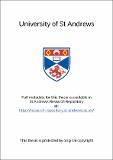Files in this item
Free radical rearrangements in synthesis
Item metadata
| dc.contributor.advisor | Walton, J. C. (John Christopher) | en |
| dc.contributor.author | Hindson, Andrew Charles | en |
| dc.coverage.spatial | 241p | en |
| dc.date.accessioned | 2021-04-08T08:57:17Z | |
| dc.date.available | 2021-04-08T08:57:17Z | |
| dc.date.issued | 1993 | |
| dc.identifier.uri | https://hdl.handle.net/10023/21865 | |
| dc.description.abstract | In chapter 1, the syntheses of a number of 2,2- disubstituted 4,7- dihydro-l,3-dioxepins are described, together with EPR studies on the radicals derived from these compounds. In the case of 2-bromomethyl-2- phenyl-4,7-dihydro-l,3-dioxepin, bromine abstraction was achieved with tin radicals to yield a CH₂. rotor type radical. This radical was studied by EPR spectroscopy and an exchange broadening process was observed. The experimental spectra were computer simulated in order to obtain the best fit rate constants and hence calculate the activation energy for rotation of the CH₂. group, which was found to be 7.7 kcal mol⁻¹. The transannular cyclisation of this compound was investigated, using the Bu₃SnH reduction method, the product proportions being measured by g.c. analysis. The rate constant and activation energy for the cyclisation were calculated to be kc₍₂₉₈₎ = 4.9 x 10^5 s⁻¹, Eₐ= 9.02 kcal mol⁻¹. The hydrolysis reaction of the bicyclic ketal produced by cyclisation, l-phenyl-2,7-dioxabicyclo[3.2.1]octane was investigated. EPR studies were carried out on the allyl type radicals formed by hydrogen abstraction from the C(4) or C(7) positions on the 1,3-dioxepin molecules. In the case of the 2,2-dimethyl-, and 2,2-diethyl-1,3-dioxepins, the exchange broadening process observed ( due to conformational changes in the ring ) was computer simulated and the activation energies for ring inversion were calculated to be 8.1 kcal mol⁻¹, and 6.1 kcal mol⁻¹respectively for the two compounds. Chapter 2 reports the syntheses of some 2,2-disubstituted 4,7-dihydro-1.3-dithiepins. Several of these compounds were studied by EPR in the presence of t-BuO. radicals. The expected allyl type radical (analogous to that of the 1,3-dioxepins) was not observed. Instead another radical of a secondary nature was found to be present, formed either by rearrangement of the dithiepin molecule, or by some decomposition process. Some photolysis / product analysis type reactions were carried out on the dithiepins using GC / MS to identify the fragmentation products of these molecules. Chapter 3 describes the EPR, photolysis, and bromination studies on three cyclic epoxides - cyclopentene oxide, cyclohexene oxide, and cyclo-octene oxide. Photolysis reactions were performed in the presence of CCl₃Br and di-tert butyl peroxide, and brominations involved NBS and Br₂/CCl₄ The products were analysed by GC/MS. Chapter 4 describes the examination of " interior chain extension " type reactions, and the EPR study of a number of cyclopropane derivatives, together with the reactions of selected compounds with the radical precursors NBS and (Me₃Si₂)NBr. | en |
| dc.language.iso | en | en |
| dc.publisher | University of St Andrews | en |
| dc.subject.lcc | QD471.H5 | |
| dc.subject.lcsh | Free radicals (Chemistry) | en |
| dc.title | Free radical rearrangements in synthesis | en |
| dc.type | Thesis | en |
| dc.type.qualificationlevel | Doctoral | en |
| dc.type.qualificationname | PhD Doctor of Philosopy | en |
| dc.publisher.institution | The University of St Andrews | en |
This item appears in the following Collection(s)
Items in the St Andrews Research Repository are protected by copyright, with all rights reserved, unless otherwise indicated.

